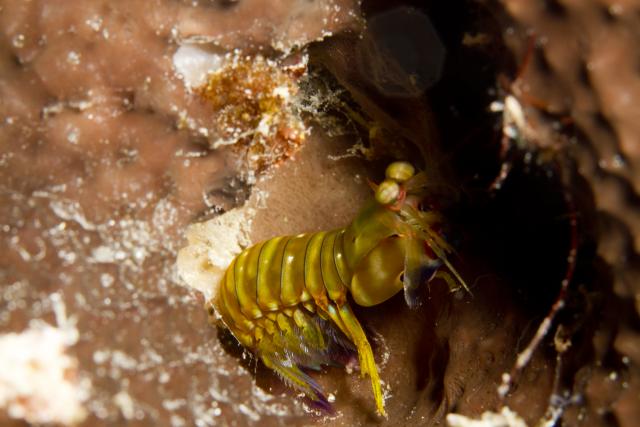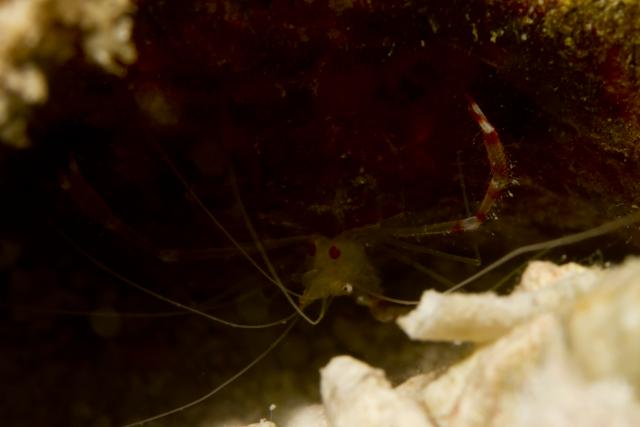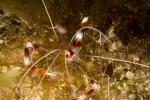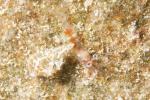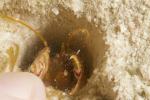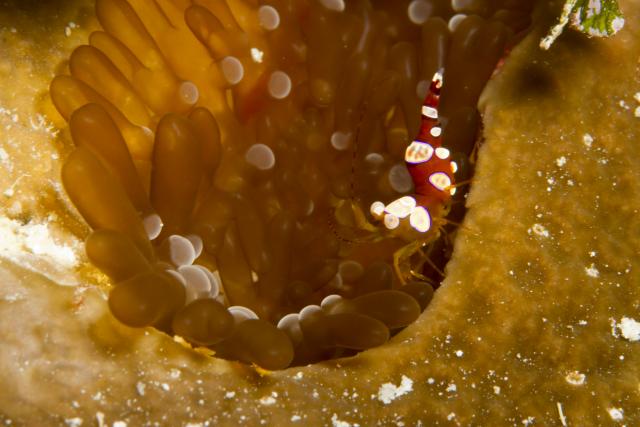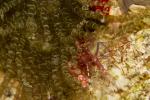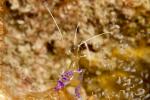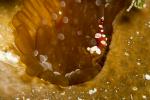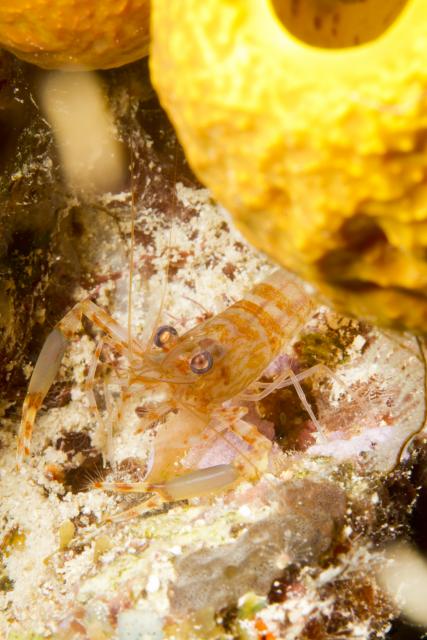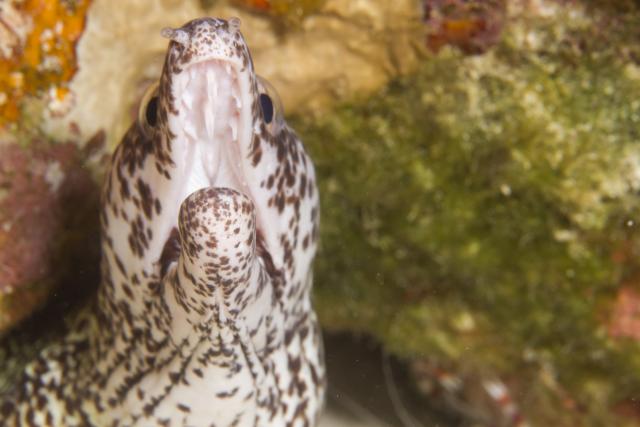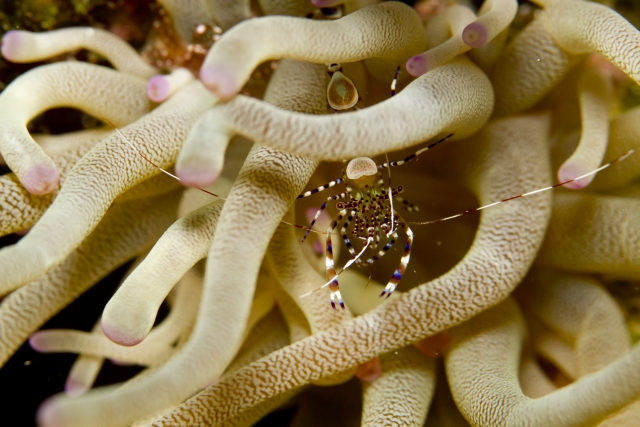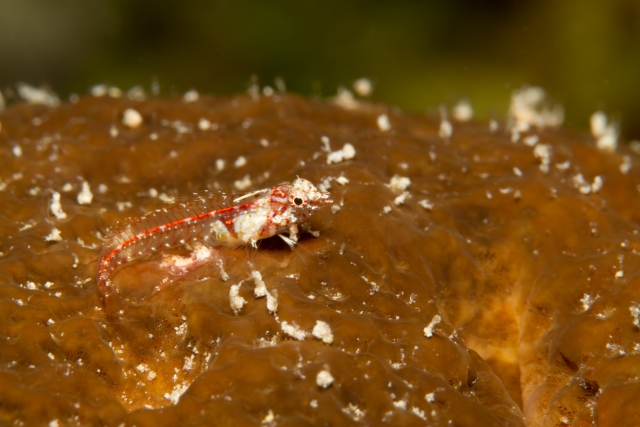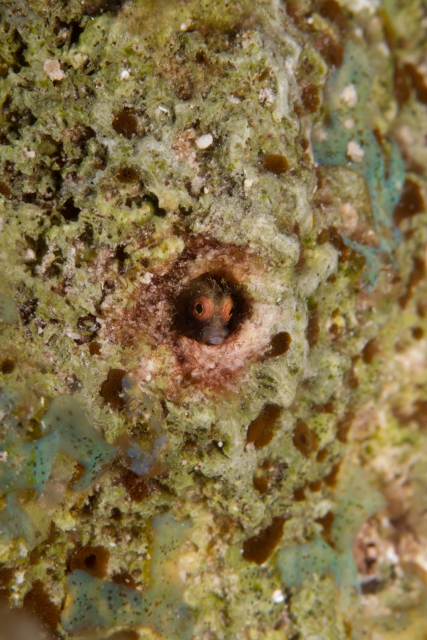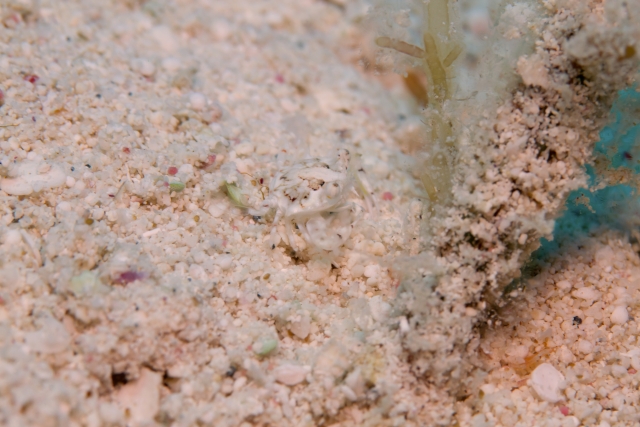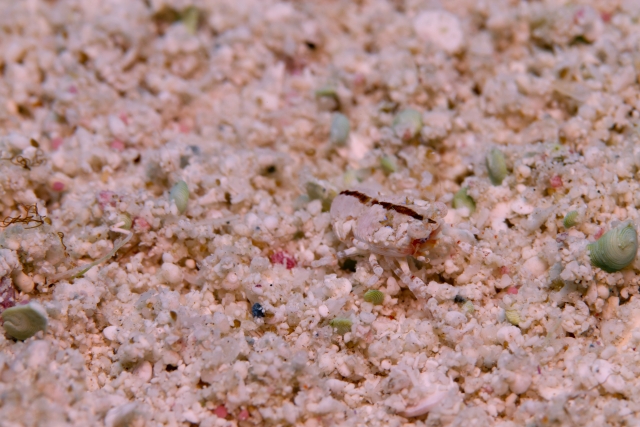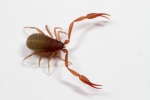shrimp
Poll: Turks and Caicos Explorer 2015: Two Claw Shrimp
ktuli — Tue, 01/05/2016 - 18:39
OK - I alluded to posting this twice now (once during the "Shrimp Platter" post and again in the Gaudy Clown Crab post), so it is high time I shared this shot of a Two Claw Shrimp (Brachycarpus biunguiculatus) that I took on our last dive. This little guy was inside the same sponge that the second Gaudy Clown Crab was, and initially he was hiding all the way at the bottom, but with some patience, I was able to get him to come into a better spot for a photo.
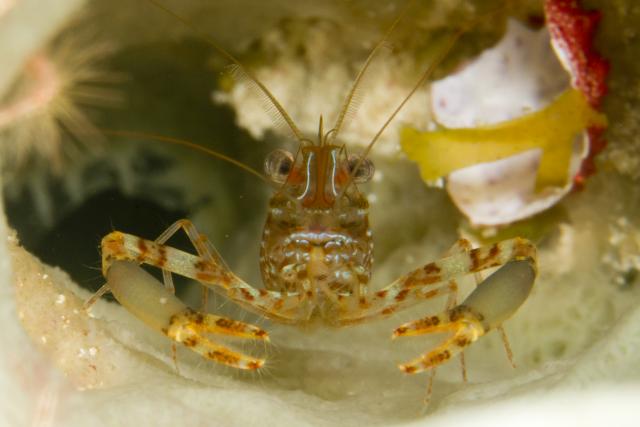 |
||
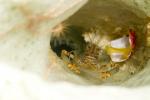 Original |
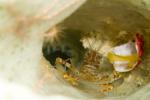 Simple Crop |
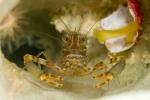 Tighter Crop and Rotate |
Technical Data: Canon EOS 7D, Canon EF 100mm f/2.8L Macro IS USM, 1/200th sec at f/25. Image Stabilization on. ISO 400. Ikelite Housing and Port and Ikelite 161 Strobe in TTL Mode. Raw conversion and cropped in Photoshop CS5.
- Bill
Turks and Caicos Explorer 2015: Dark Mantis Shrimp
ktuli — Thu, 12/10/2015 - 17:33
So when we went to Wakatobi, mantis shrimp were definitely on my list of things to look for. When we're in the Caribbean, they're not something I expect to see, so when we managed to find three separate ones on this trip, it was pretty impressive. I don't know if this is just luck, or if Anya is getting better at spotting them (she located all three).
The first one I didn't even get to take any photos of. The last one I only managed to get a shot of it once it had retreated back to its burrow and would only stick its head out (I might have been able to wait it out a bit longer to see if it would come out, but there was a ton of other stuff to photograph on that dive). But this one... this was the cream of the crop! Anya spotted this one in the bottom of a small barrel sponge.
Technical Data: Canon EOS 7D, Canon EF 100mm f/2.8L Macro IS USM, 1/200th sec at f/16. Image Stabilization on. ISO 400. Ikelite Housing and Port and Ikelite 161 Strobe in TTL Mode. Raw conversion in Photoshop CS5.
It is a Dark Mantis (Neogonodactylus curacaoensis) and they grow to about 2 inches in length, which is about how big this guy was. They're pretty quick and I had to move and think just as quick to try and get the photos I did. I didn't want my camera to go into an auto-focus hunt mode, so I was trying to make minor adjustments with the manual adjustment knob and use the AF button as little as possible, which explains both why there aren't quite as sharp as they could be and that some of them are a bit too close - I wish I had backed up a little and gotten the whole mantis in the shot.
But all things considered (especially that it was only out of its burrow for a minute), I am pretty happy with the results.
 |
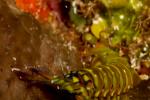 |
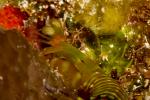 |
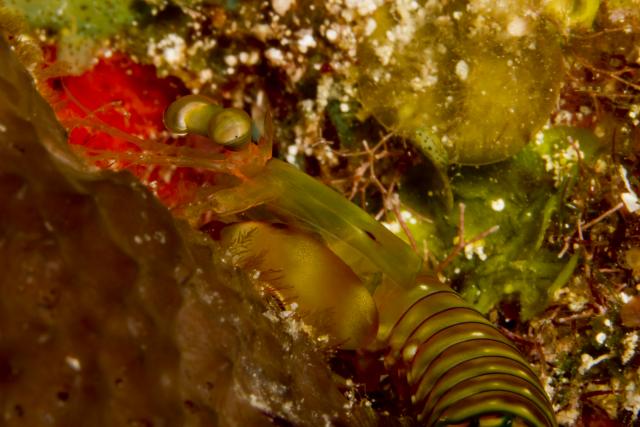 |
||
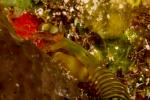 |
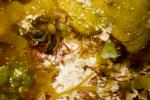 |
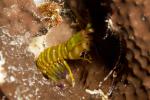 |
This really was one of the highlights of the trip.
- Bill
Turks and Caicos Explorer 2015: Shrimp Platter
ktuli — Wed, 12/02/2015 - 19:39
Alright - if you've been following along with my dive photography, you'll probably know that shrimp are among my favorite underwater subjects. This trip provided me another batch of really great opportunities to photograph shrimp. For the most part, nothing too flash (sorry, I will be saving the crème de la crème of the shrimp from this trip for another post), but some good shots of some shrimp that have been elusive in the past and some new shrimp that I've never seen in the wild before (but have looked at in the ID book and wanted to find!).
First up is one of those shrimp I've always wanted to see, and oddly enough I didn't realize I had seen one when I took this photo. I thought I was photographing a Banded Coral Shrimp (there'll be a photo of one of them further down) because of how this little guy was hidden up under this coral. However, what we actually have here is a Golden Coral Shrimp (Stenopus scutellatus) - the dead give-away is that pair of red spots on its front. Unfortunately it isn't the best photograph, and had I known what I was looking at I would have spent more time with this subject (but it was actually on the very first dive of the week, and I was still a little over-excited just to be back in the water!).
Technical Data: Canon EOS 7D, Canon EF 100mm f/2.8L Macro IS USM, 1/200th sec at f/16. Image Stabilization on. ISO 400. Ikelite Housing and Port and Ikelite 161 Strobe in TTL Mode. Raw conversion in Photoshop CS5.
Next up is another shrimp that I've technically seen before, and I've gotten a really bad photograph of previously, and I technically only got photograph of its claws this time. It is an Orange Ghost Shrimp (Corallianassa longiventris) - with thanks to Andi for the updated version of the Reef Critter book for the ID - and it is quite the shrimp. Reading up on them now that I am home, I am wishing we had been more patient with them when we found them and tried to get them to come further out of their burrows for a better shot. Luckily, Mike figured out that they like to eat seaweed and was feeding the couple that we found which provided for the shots I did get...
Technical Data: Canon EOS 7D, Canon EF 100mm f/2.8L Macro IS USM, 1/160th sec at f/25. Image Stabilization on. ISO 400. Ikelite Housing and Port and Ikelite 161 Strobe in TTL Mode. Raw conversion in Photoshop CS5.
This last one was another I had seen in the book but was unimpressed with until I'd seen them in person. This shot below I captured on the first night dive of the week, and was really happy with the shot. Anya found me another one (well, technically she didn't know she found it for me, but I'll still give her credit) that I will share later as I have not yet processed the photos from that dive, but I am still happy with this shot and it certainly makes this shrimp look way cooler than it does in the ID book...
Technical Data: Canon EOS 7D, Canon EF 100mm f/2.8L Macro IS USM, 1/160th sec at f/25. Image Stabilization on. ISO 400. Ikelite Housing and Port and Ikelite 161 Strobe in TTL Mode. Raw conversion in Photoshop CS5.
In case you're wondering (and if you're still reading, I know that you are), that is apparently a Two Claw Shrimp (Brachycarpus biunguiculatus) - I know, I pretty non-descript name for a fairly cool looking shrimp. I'm thinking Big Claw Tiger Shrimp would be a better name, but I'm hoping that name is already taken for something else that looks even cooler and I'll get the chance to find that some day in the future!
- Bill
Turks and Caicos Explorer 2015: Impressive Teeth
ktuli — Sun, 11/29/2015 - 11:55
You might think that a post with the title of "Impressive Teeth" might be about a shark or perhaps even a baracuda, but no... these particular set of chompers belong to a "small-ish" eel.
Spotted Morays (Gymnothorax moringa) are pretty common on the reef, and they are often pretty bold and will hold their ground and allow a close approach, making for some nice close-up shots. They also need to continually force water over their gills by opening and closing their mouths which allows for a nice view of their impressive fangs. It might appear intimidating at first, but they are rarely aggressive.
Technical Data: Canon EOS 7D, Canon EF 100mm f/2.8L Macro IS USM, 1/160th sec at f/16. Image Stabilization on. ISO 400. Ikelite Housing and Port and Ikelite 161 Strobe in TTL Mode. Raw conversion in Photoshop CS5.
The most impressive things about their teeth? Notice that third row of teeth down the middle? They're the only animal that I know of that have those. They've meant to help them catch and hold fish. (Oh - and check out the bonus banded coral shrimp in the above shot).
Here's a slightly closer shot...
Technical Data: Canon EOS 7D, Canon EF 100mm f/2.8L Macro IS USM, 1/160th sec at f/16. Image Stabilization on. ISO 400. Ikelite Housing and Port and Ikelite 161 Strobe in TTL Mode. Raw conversion in Photoshop CS5.
- Bill
Aqua Cat: More Spotted Cleaner Shrimp
ktuli — Thu, 01/29/2015 - 19:45
Here's a couple more angles of that Spotted Cleaner Shrimp...
Technical Data: Canon EOS 7D, Canon EF 100mm f/2.8L Macro IS USM, 1/200th sec at f/8. Image Stabilization on. ISO 400. Ikelite Housing and Port and Ikelite 161 Strobe in TTL Mode. Raw conversion in Photoshop CS5.
Technical Data: Canon EOS 7D, Canon EF 100mm f/2.8L Macro IS USM, 1/200th sec at f/8. Image Stabilization on. ISO 400. Ikelite Housing and Port and Ikelite 161 Strobe in TTL Mode. Raw conversion in Photoshop CS5.
Technical Data: Canon EOS 7D, Canon EF 100mm f/2.8L Macro IS USM, 1/200th sec at f/8. Image Stabilization on. ISO 400. Ikelite Housing and Port and Ikelite 161 Strobe in TTL Mode. Raw conversion in Photoshop CS5.
Have a nice weekend!
- Bill
Pederson's Shrimp
ktuli — Tue, 01/27/2015 - 18:55
Not as flash as the Spotted Cleaner Shrimp, but much more common, Pederson's Shrimp are always a fun find and a challenging photo subject. Their skinny bodies and long antennae make them difficult to get in focus. However, if you can get a bold one and hold your hand still in front of them, they will sometimes hop on your hand and pick off any dead skin around your fingernails.
Technical Data: Canon EOS 7D, Canon EF 100mm f/2.8L Macro IS USM, 1/200th sec at f/8. Image Stabilization on. ISO 400. Ikelite Housing and Port and Ikelite 161 Strobe in TTL Mode. Raw conversion in Photoshop CS5.
- Bill
Poll: Aqua Cat: Spotted Cleaner Shrimp
ktuli — Sun, 01/25/2015 - 21:19
Alright! I have finally made it through all the photos from my (at this point, not so) recent dive trip. I really should have finished them a long while ago, since the last dive certainly had a couple gems in them - in particular in the form of an encounter with a Spotted Cleaner Shrimp (Periclimenes yucatanicus). It was definitely a challenging subject due to the continually undulating anemone that it was hiding in, but I did manage several really sharp photos, and this particular one worked pretty well in several different crops... take a look and then cast your vote for which one you like best.
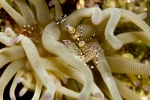 Original |
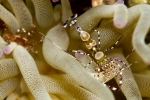 2:3 Crop |
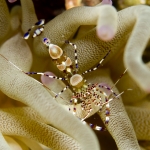 Square Crop |
|
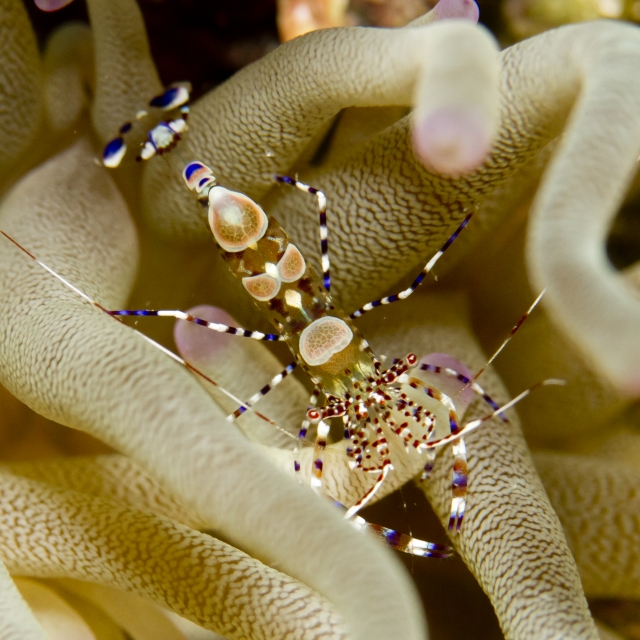
| |||
Technical Data: Canon EOS 7D, Canon EF 100mm f/2.8L Macro IS USM, 1/200th sec at f/8. Image Stabilization on. ISO 400. Ikelite Housing and Port and Ikelite 161 Strobe in TTL Mode. Raw conversion and cropped in Photoshop CS5.
Honestly, I didn't even notice the crab also hiding in the anemone at the time - I was so focused on capturing a species of shrimp that I'd never seen before.
There are still a handful more good shots from the trip, so hopefully I'll post a little more frequently to get them shared here. Stay tuned.
- Bill
Aqua Cat: Critter Assortment
ktuli — Fri, 11/14/2014 - 23:02
Ok - so time for another assortment, and admittedly it is mostly crabs, but I'm saving some nudibranch shots for the next post, so stay tuned...
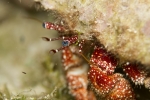 |
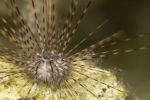 |
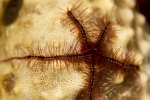 |
 |
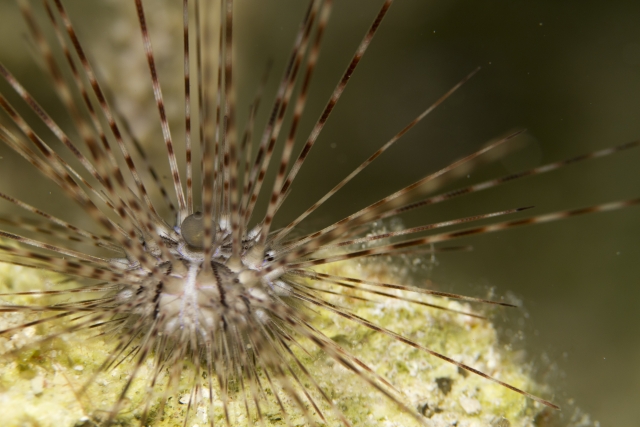 |
|||
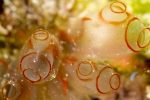 |
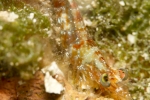 |
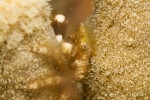 |
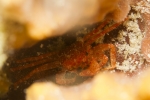 |
- Bill
Aqua Cat: Midnight Snack
ktuli — Mon, 11/10/2014 - 18:59
Ok - I know I have mentioned this in the past, but during night dives, you quite often get swarmed with blood worms. To be honest, I hate them... they are super annoying, they get in the way of your photos (more on that later), and they can swarm your camera and get clumped up in your strobe and you don't notice it and you put your strobe in your camera case and they all die and your camera case smells horrible (yeah - true and quite disgusting story).
Anyway, there are a couple ways you can deal with them on a dive. First, you can just turn your lights out and swim around in the dark for a while and they go away (I had to resort to this several times this trip. It isn't ideal as it does get a bit spooky being down there with no light at all, but if you stay semi-close to another diver, you can sort of see). Second, you can dump them off on another diver - sort of the same principle here, but you just take your light next to theirs, then turn yours off and swim away... the person with a light on gets stuck with all the blood worms.
And then there's option three... feed stuff with them. This time, it is a banded coral shrimp (Stenopus hispidus) that managed to snag one and have a nice meal on me.
Technical Data: Canon EOS 7D, Canon EF 100mm f/2.8L Macro IS USM, 1/200th sec at f/6.3. Image Stabilization on. ISO 400. Ikelite Housing and Port and Ikelite 161 Strobe in TTL Mode. Raw conversion and cropped in Photoshop CS5. (mouseover for original uncropped version).
I really should have been shooting with a narrower aperture to get more depth of field, but I did manage to get this one with the focus right on the shrimp's face. Unfortunately, with all those legs and antennae and blood worms swimming around, there is a bit of visual confusion in this shot.
But still, it is one less blood worm in the world, and one happier banded coral shrimp with a full belly.
- Bill
Turks and Caicos Explorer: Find the Reef Critter
ktuli — Mon, 12/03/2012 - 20:25
So if you've been following along, you'll know that I love finding the little stuff. On land, it is one thing... and I'm constantly looking for bugs and spiders. On the reef, it takes on an entirely new challenge. Like the search for the Gaudy Clown Crab, finding interesting and beautiful tiny little creatures while on a dive is something I take great pride in doing.
Normally I would post cropped photos with their originals available with a mouse-over action. Instead, for these, I'm going to post the original and let you see if you can spot the tiny little critter. If you're having a hard time, simply mouse-over the image for a cropped view that should help...
We'll start off with something easy...
Technical Data: Canon EOS 7D, Canon EF 100mm f/2.8L Macro IS USM, 1/200th sec at f/16. Image Stabilization on. ISO 160. Ikelite Housing and Port with Ikelite 161 Strobe in TTL Mode. Raw conversion in Photoshop CS5.
Too easy? Ok - well, think about it this way. That shot was taken at 1:1.5 magnification. That means the frame is 1.3 inches x 0.9 inches. Looking at how much of the frame that Roughhead Triplefin (Enneanectes boehlkei) takes up, I'd estimate that it was only a mere 0.75 inches long. Sure - he stands out while sitting on top of that sponge, but still... that is a translucent bodied fish with some white markings (that mimic the white detritus stuck to the sponge) in a vast ocean.
Ok - this next one should be fairly easy too...
Technical Data: Canon EOS 7D, Canon EF 100mm f/2.8L Macro IS USM, 1/200th sec at f/16. Image Stabilization on. ISO 160. Ikelite Housing and Port with Ikelite 161 Strobe in TTL Mode. Raw conversion in Photoshop CS5.
That shot is also at 1:1.5 magnification, which makes that little guy about 0.15 inches high if my math is right. It is either a Roughhead (note the fringes above its eyes in the zoomed version) Blenny (Acanthemblemaria aspera) or a Secretary Blenny (Acanthemblemaria maria) - I can't tell which without more visibility to the markings on the side of the fish. I posted another blenny from last year's trip as well for more examples of these tiny little fish.
Alright, that's enough of the easy ones. Now we'll take a look at where camouflage and tiny size come together to make for an truly difficult find...
Technical Data: Canon EOS 7D, Canon EF 100mm f/2.8L Macro IS USM, 1/160th sec at f/11. Image Stabilization on. ISO 160. Ikelite Housing and Port with Ikelite 161 Strobe in TTL Mode. Raw conversion in Photoshop CS5.
That little guy is some sort of crab. I'm not able to find it in any of the identification books I have (not really surprising). Who knows - it could be a baby of some larger species of crab, or it could be that small all the time. Perhaps I found something no one else has ever seen before. All I know it is was tiny - probably in the range of 1/5th of an inch - and blended in perfectly with the sand.
Technical Data: Canon EOS 7D, Canon EF 100mm f/2.8L Macro IS USM, 1/200th sec at f/11. Image Stabilization on. ISO 160. Ikelite Housing and Port with Ikelite 161 Strobe in TTL Mode. Raw conversion in Photoshop CS5.
That ridiculously tiny and cryptic thing appears to be some sort of shrimp or maybe even a lobster larvae. Once you see it, that dark stripe really stands out, but considering this was spotted just out on the sand, it really wasn't easy to spot.
Having said all that, don't ask how I spot these things - the answer is "I just do". I can't explain it, I can't tell you what specifically I look for - I just scan constantly and things jump out at me. A line that breaks a pattern (eyes are usually a dead giveaway), or a pattern itself in some camouflage, or a tiny bit of movement - regardless of what it is, my eyes are constantly searching when I'm on a dive. Searching for the next awesome little critter to zoom in on and reveal a view on something most people don't get to see.
When's my next dive trip scheduled???
- Bill

